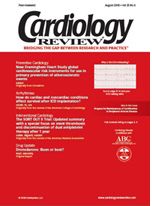Publication
Article
Dual PPAR agonists improve glycemic control, lipids in type 2 diabetes
Diabetes and lipid disorders
San Diego—The first drug to reach phase 3 trials in a promising new class of agents called the dual alpha/
gamma peroxisome proliferator-activated receptor (PPAR) agonists is superior to pioglitazone in improving lipid parameters and achieving long-term glycemic control, said David Kendall, MD, at the 65th Annual Scientific Sessions of the American Diabetes Association.
The agent, muraglitazar, targets the PPARs. The thiazolidinediones target PPAR-gamma, thereby improving insulin sensitivity and glycemic control. In addition to PPAR-gamma, muraglitazar has activity at PPAR-alpha, which is associated with regulation of lipids.
A second dual PPAR agonist, tesaglitazar, reduced fasting plasma glucose and improved lipid parameters in comparison with placebo in a phase 2 study.
“These new compounds address three of the most critical areas in diabetes: glucose control, triglycerides, and high-density lipoprotein [HDL],” said Dr. Kendall, associate professor of medicine, University of Minnesota Medical School.
In a trial of 1,159 patients with type
2 diabetes who had not reached adequate glycemic control goals despite treatment with 1,500 mg/day or more of metformin, patients were randomly assigned to receive either 5 mg of muraglitazar or 30 mg of pioglitazone daily for
24 weeks while metformin doses were maintained at baseline levels. HMG-CoA reductase inhibitor (statin) therapy was permitted, as needed, after the first 12 weeks of the study.
After 24 weeks, patients assigned to muraglitazar had a mean reduction in glycosylated hemoglobin (A1C) of 1.14% compared with a mean reduction of 0.85% in the pioglitazone recipients (P < .001). Sixty percent of the muraglitazar group versus 45% of pioglitazone patients achieved goal A1C levels of less than 7% (P < .001).
Fasting plasma glucose levels were reduced by 44 mg/dL from baseline in the muraglitazar group and 33 mg/dL in the pioglitazone group (P < .001). Muraglitazar also produced significantly greater reductions in fasting plasma insulin than did pioglitazone (5.0 mU/mL versus 3.6 mU/mL;
P < .001).
Muraglitazar was also associated with a 30% reduction in C-reactive protein levels compared with a 24% reduction in pioglitazone-treated patients (P = .04) and a 30% reduction in plasminogen-activator inhibitor-1 levels compared with a 22% decrease with pioglitazone (P = .002).
Muraglitazar-treated patients had significant improvements in lipid values at 12 weeks (before statin initiation). Patients assigned to muraglitazar experienced a 28% reduction in triglyceride levels from baseline compared with a 14% reduction for pioglitazone-treated patients (P = .001). Among those who had triglyceride levels greater than 150 mg/dL at baseline, muraglitazar was associated with a 35% reduction versus a 19% reduction for pioglitazone (P < .001).
HDL cholesterol values increased 19% in the muraglitazar group at 12 weeks, compared with 14% in the pioglitazone group (P = .001). Non-HDL cholesterol levels decreased by 6%, apolipoprotein B levels decreased by 12%, and free fatty acid levels decreased by 30% with muraglitazar, compared with decreases of 1%, 6%, and 21%, respectively, for pioglitazone (P < .001 for all values).
Preliminary analysis of a 26-week continuation of the study shows that the glycemic control and lipid differences between the two treatment groups were maintained or increased after 50 weeks of total treatment time.
In an extension of a previous dose-ranging, phase 2 trial, patients taking 5 mg of muraglitazar maintained A1C levels that were 1.52% below baseline after 104 weeks’ treatment. “This 2-year durability study shows that the 5-mg dose has remarkable stability of glucose control,” Dr. Kendall said.
Weight gain was greater with muraglit-
azar than pioglitazone (mean: 1.4 kg versus 0.6 kg). “The initiation of metformin treatment with muraglitazar may limit weight gain,” Dr. Kendall said.
Four muraglitazar-treated patients developed adverse events related to heart failure compared with one patient in the pio-
glitazone group, all of which resolved with diuretic therapy and/or withdrawal of the study drug. Hypoglycemia occurred in three patients in the muraglitazar group and one in the pioglitazone group, but no hypoglycemia-related serious events or study withdrawals occurred due to hypoglycemia.
Tesaglitazar was studied in a 12-week, randomized, double-blind, placebo-controlled, phase 2, dose-ranging (0.1 to 3.0 mg) study of 500 patients with type 2 diabetes. Compared with placebo, fasting plasma glucose was reduced in a dose-dependent fashion by up to 61 mg/dL
(P < .001), fasting triglycerides were reduced by up to 41% in a dose-dependent manner (P < .001), HDL cholesterol increased by 15% (P < .001) with a plateau reached at 1.0 mg of tesaglitazar, and low-density lipoprotein cholesterol was reduced in a dose-dependent manner by up to 17% (P < .001).
“The past focus in type 2 diabetes management has been glucose; however, there is an increasing need for a single agent that can target both glucose and dyslipidemia associated with type 2 diabetes,” said lead investigator Barry J. Goldstein, MD, PhD, director of the division of endocrinology, diabetes and met-abolic diseases at Jefferson Medical College, Philadelphia.
